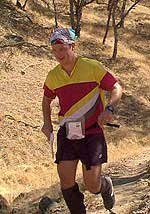
Course Setting Guidelines
Here are some guidelines for setting courses at BAOC meets. For more information, talk to the club's technical director or event quality director.
- Measuring distance and climb
- Course specs
- Course by course details
- Course Setter's Workshop, by Evan Custer
These detailed guidelines focus on the general principles of coursesetting and cover the full range of duties, from desktop planning to hanging the controls. (Also available in a printable PDF version.)
Measuring Distance and Climb
Course distance (in kilometers) is the total straight line distance measured between controls on the map. Obviously, actual distance depends on a competitors' route choice.
Course climb (in meters) is measured as the total ascent along the OPTIMAL route between controls - that is, the number of uphill contours (don't count descents). This is NOT the straight-line distance or minimal number of contours between two controls, but rather the logical route choice, including lost elevation when contouring through large reentrants. Don't underestimate your climb figures - be as accurate as possible; the participants will thank you for it.
Total climb should be up to 4 percent of the distance. You can increase the climb to 7 percent in some Bay Area parks (you often don't have much choice). If you want to make a course tougher, increase its technical difficulty, NOT the climb. Nobody appreciates extra climb (also known as "gratuitous violence").
For more information, see Joe Scarborough's treatise, "Measuring Distance and Climb".
Course Specs
Set the distance so the top runner (known as a 100-point runner) for each course can complete it in the time shown in the following table. The distances shown here are representative. We don't have many 100-point runners in our club, so expect winning times to be longer for some of the courses. James Scarborough is about a 100-point runner on Blue courses; if he finishes in the time shown in the following table, the course was probably set with the right length and climb.
The specification that takes precedence is in bold. Specifcations which deviate from USOF guidelines are in italics. These are official BAOC guidelines as adopted at September and December 1998 board meetings. "Distance Ratio" refers to the length of the course as compared to Blue.
| Course | Difficulty Level (navigation) |
Winning Time (minutes) |
Approx. Distance (kilometers) |
Distance Ratio (percent) |
|---|---|---|---|---|
| White | Beginner | 25-30 | 1.5-3.0 | 20-25 |
| Pink | Beginner | 50-60 | 4.0-8.0 | 60 |
| Yellow | Advanced Beginner | 35-40 | 2.0-3.5 | 30-35 |
| Orange | Intermediate | 50-55 | 3.0-5.0 | 40-45 |
| Brown | Advanced | 45-50 | 2.5-4.5 | 34-38 |
| Green | Advanced | 50-55 | 3.5-7.0 | 50-55 |
| Red | Advanced | 60-65 | 5.0-10.0 | 70-75 |
| Blue | Advanced | 75-80 | 7.0-14.0 | 100 |
Course-by-Course Details
White course
White is designed for beginning orienteers and young people under 12 years old. All controls should be on trails or handrails (fences, streams) that are easy to follow. It is often recommended to place controls at decision points on the course, but there should only be ONE route choice. Climb should be kept to a minimum.
Avoid the temptation to set a challenging White course. The White course can never be too easy; remember, these are first-time or young orienteers who are just learning to read the map and associate it with their surroundings.
The distance should be 1.5 to 3 kilometers, with shorter distances in our steeper or more rugged parks.
Pink course
Pink is rarely set at orienteering events. It's essentially a long White for those who want a longer course but who prefer to stay on trails and easily find controls. This course should as easy as White but as long as Red.
The distance should be 4 to 8 kilometers, with shorter distances in our steeper or more rugged parks.
Yellow course
Yellow is designed for advanced beginners who need to follow handrails (preferably not trails) to the area of a control but are ready to leave the handrail near the control. Controls should be on or within sight of handrails. Controls do not need to be placed near decision points. Leg lengths should not vary much. The fewer trails you use as handrails, the better-prepared Yellow orienteers will be for intermediate courses.
The distance should be 2 to 3.5 kilometers, with shorter distances in our steeper or more rugged parks.
Orange course
Orange is designed for intermediate orienteers who are ready to begin going cross-country. There should be two route choices to each control. One route should be a direct cross-country route, and the other should be a longer handrail route. Normally, the cross-country route should give the better time for the more advanced intermediate orienteers.
Leg lengths should vary. Orienteers should be encouraged to use compasses and simple contouring to cut corners. Cross-country routes should have large features that can serve as attack points.
The distance should be 3 to 5 kilometers, with shorter distances in our steeper or more rugged parks.
Brown, Green, Red, and Blue courses
The advanced courses are designed for orienteers able to make full use of their maps, compasses, and the terrain. The navigational difficulty is exactly the same for all four courses; the difference lies in the total distance and climb. The Brown course should have a minimum of physical punishment; the Blue course should be the most physical.
These courses should be completely cross-country (minimal use of trails) and should encourage orienteers to interpret complex contour and feature details. Legs should vary in length. Control sites should be on point featurs far from obvious relocation points. Errors can result in large time losses for the longer courses.
